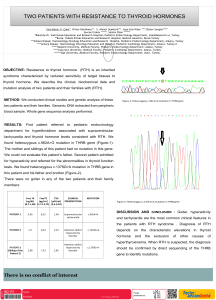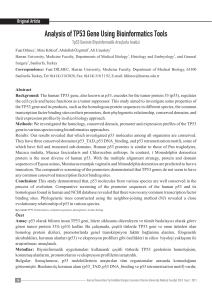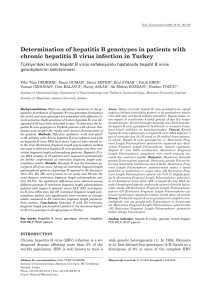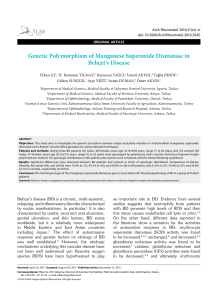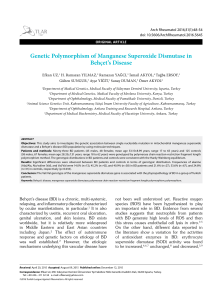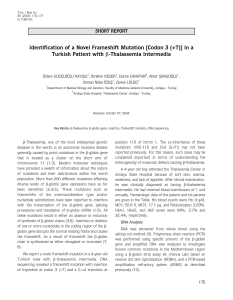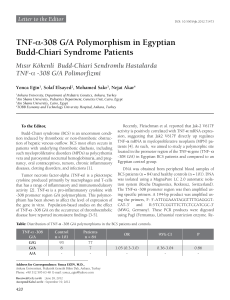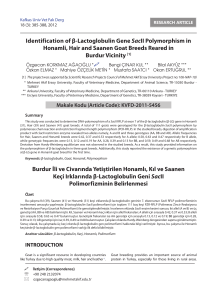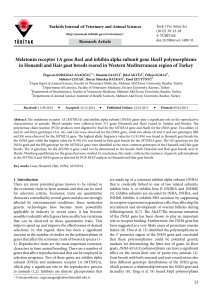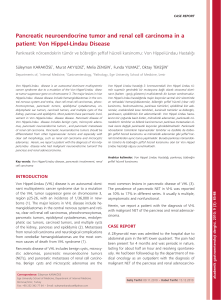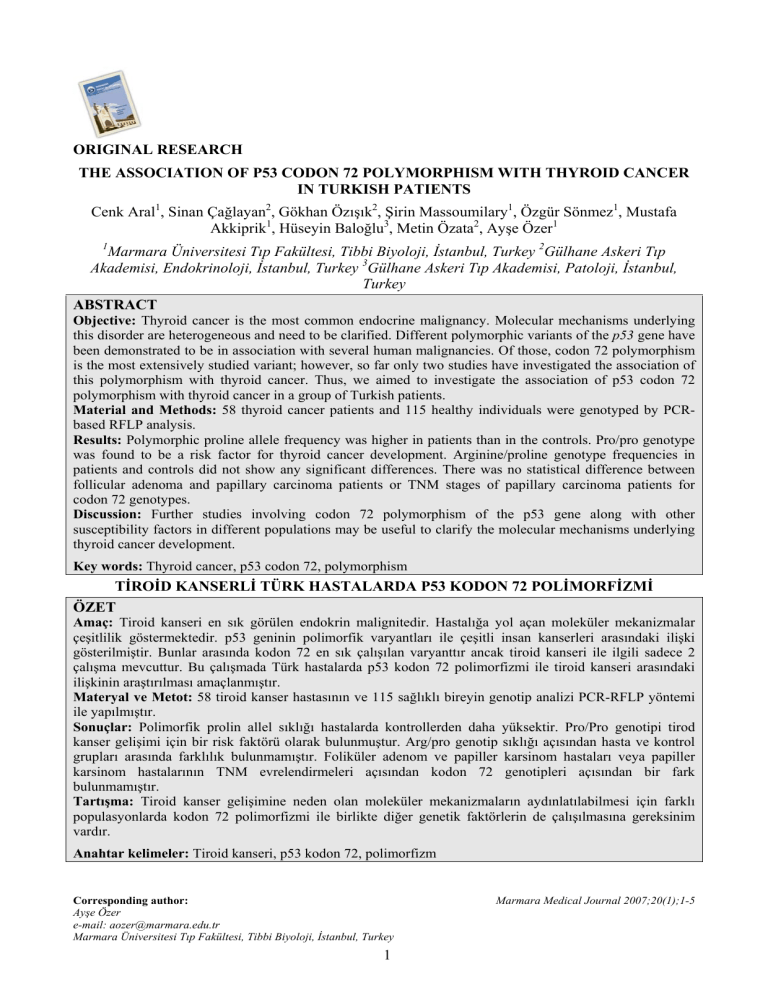
ORIGINAL RESEARCH
THE ASSOCIATION OF P53 CODON 72 POLYMORPHISM WITH THYROID CANCER
IN TURKISH PATIENTS
Cenk Aral1, Sinan Çağlayan2, Gökhan Özışık2, Şirin Massoumilary1, Özgür Sönmez1, Mustafa
Akkiprik1, Hüseyin Baloğlu3, Metin Özata2, Ayşe Özer1
1
Marmara Üniversitesi Tıp Fakültesi, Tibbi Biyoloji, İstanbul, Turkey 2Gülhane Askeri Tıp
Akademisi, Endokrinoloji, İstanbul, Turkey 3Gülhane Askeri Tıp Akademisi, Patoloji, İstanbul,
Turkey
ABSTRACT
Objective: Thyroid cancer is the most common endocrine malignancy. Molecular mechanisms underlying
this disorder are heterogeneous and need to be clarified. Different polymorphic variants of the p53 gene have
been demonstrated to be in association with several human malignancies. Of those, codon 72 polymorphism
is the most extensively studied variant; however, so far only two studies have investigated the association of
this polymorphism with thyroid cancer. Thus, we aimed to investigate the association of p53 codon 72
polymorphism with thyroid cancer in a group of Turkish patients.
Material and Methods: 58 thyroid cancer patients and 115 healthy individuals were genotyped by PCRbased RFLP analysis.
Results: Polymorphic proline allele frequency was higher in patients than in the controls. Pro/pro genotype
was found to be a risk factor for thyroid cancer development. Arginine/proline genotype frequencies in
patients and controls did not show any significant differences. There was no statistical difference between
follicular adenoma and papillary carcinoma patients or TNM stages of papillary carcinoma patients for
codon 72 genotypes.
Discussion: Further studies involving codon 72 polymorphism of the p53 gene along with other
susceptibility factors in different populations may be useful to clarify the molecular mechanisms underlying
thyroid cancer development.
Key words: Thyroid cancer, p53 codon 72, polymorphism
TİROİD KANSERLİ TÜRK HASTALARDA P53 KODON 72 POLİMORFİZMİ
ÖZET
Amaç: Tiroid kanseri en sık görülen endokrin malignitedir. Hastalığa yol açan moleküler mekanizmalar
çeşitlilik göstermektedir. p53 geninin polimorfik varyantları ile çeşitli insan kanserleri arasındaki ilişki
gösterilmiştir. Bunlar arasında kodon 72 en sık çalışılan varyanttır ancak tiroid kanseri ile ilgili sadece 2
çalışma mevcuttur. Bu çalışmada Türk hastalarda p53 kodon 72 polimorfizmi ile tiroid kanseri arasındaki
ilişkinin araştırılması amaçlanmıştır.
Materyal ve Metot: 58 tiroid kanser hastasının ve 115 sağlıklı bireyin genotip analizi PCR-RFLP yöntemi
ile yapılmıştır.
Sonuçlar: Polimorfik prolin allel sıklığı hastalarda kontrollerden daha yüksektir. Pro/Pro genotipi tirod
kanser gelişimi için bir risk faktörü olarak bulunmuştur. Arg/pro genotip sıklığı açısından hasta ve kontrol
grupları arasında farklılık bulunmamıştır. Foliküler adenom ve papiller karsinom hastaları veya papiller
karsinom hastalarının TNM evrelendirmeleri açısından kodon 72 genotipleri açısından bir fark
bulunmamıştır.
Tartışma: Tiroid kanser gelişimine neden olan moleküler mekanizmaların aydınlatılabilmesi için farklı
populasyonlarda kodon 72 polimorfizmi ile birlikte diğer genetik faktörlerin de çalışılmasına gereksinim
vardır.
Anahtar kelimeler: Tiroid kanseri, p53 kodon 72, polimorfizm
Corresponding author:
Ayşe Özer
e-mail: aozer@marmara.edu.tr
Marmara Üniversitesi Tıp Fakültesi, Tibbi Biyoloji, İstanbul, Turkey
1
Marmara Medical Journal 2007;20(1);1-5
Marmara Medical Journal 2007;20(1);1-5
Cenk Aral, et al.
The association of P53 codon 72 polymorphism with thyroid cancer in turkish patients
among a group of Turkish patients with
thyroid cancer by performing genotyping in
58 patients and 115 healthy controls by a
PCR-based RFLP analysis.
PATIENTS AND METHODS
Tissue specimens and DNA extraction
Paraffin-embedded tissue specimens were
selected from 58 thyroid cancer patients.
Briefly, 6 µm thick sections were cut from
blocks that had been selected for maximal
tumor content. Total DNA extraction was
performed by using a DNA isolation kit
according to the manufacturer’s instructions
(MagneSil genomic, fixed tissue system,
Promega, USA). Isolated DNA was aliquoted
and stored at -20°C. DNA from the peripheral
leucocytes of 115 healthy controls was also
extracted by proteinase K digestion followed
by phenol/chloroform extraction as previously
described by John et al.12. The study protocol
was approved by the Research Council and
Ethics Committee of Gulhane Military
Medical School.
Genotype analysis
DNA samples were analyzed for p53 codon
72 polymorphism using PCR-based RFLP
analysis. First, a 296 bp fragment was
amplified
using
forward
(5ATCTACAGTCCCCCTTGCCG-3)
and
reverse (5-GCAACTGACCGTGCAAGTCA3) primers. The 50 µl PCR mixture contained
0.1 µg genomic DNA, 0.6 U Taq DNA
polymerase, 10 pmol of each primer, 200 µM
of each dNTPs, and 1.5 mM MgCl2. PCR
products were checked by 2% agarose gel
electrophoresis and then subjected to
restriction enzyme digestion. Briefly, 10 µl of
PCR product was mixed with 10 U of
Bsh1236I restriction enzyme (Fermentas,
Lithuania) in 1x buffer containing 10 mM tris,
10 mM MgCl2, 100 mM KCl, 0.1 mg/ml BSA
pH 8.5. The samples were incubated in 37 oC
for 19 hours to ensure complete digestion.
Digestion products were visualized under UV
transilluminator after they were separated in
4% agarose gel electrophoresis containing
ethidium bromide. The presence of wild-type
arginine allele was indicated by bands of 169
and 127 bp, whereas no digestion was
INTRODUCTION
Tumors of the thyroid gland represent a
variety of lesions from well-differentiated
benign tumors to anaplastic malignant cancer.
Approximately less than 5-10% of
hyperfunctioning thyroid nodules develop
thyroid cancer and the prevalence of these
nodules is estimated to be 5 to more than 20%
in humans1. In the United States, it is reported
that approximately 1% of all malignancies are
thyroid tumors. Several genetic factors have
been associated with thyroid cancer such as
p53, RET, BRAF, p21, Rb2. Of note, the
association of mutations and polymorphisms
of p53 have been reported in a variety of
human tumors.
Although several polymorphisms have been
identified in both coding and non-coding
regions, only two of them were shown to alter
the amino acid sequence of p53. One of these
variants is a proline (pro) to serine change at
codon 47 and the other is an arginine (arg) to
proline change at codon 72. The latter is
located in the proline-rich region of the
protein and may affect the structure of the
putative SH3-binding domain3. p53 codon 72
polymorphism have been studied in several
types of cancers; however, the results are
controversial. Although codon 72 pro/pro
genotype is associated with an elevated risk of
lung cancer4,5 other studies have not
confirmed such an association in the same
malignancy6,7. A similar controversy is
observed in breast cancer and several different
tumor types8,9, most likely due to ethnic
differences of the populations studied.
To date, only two studies have investigated
the association of codon 72 polymorphism in
thyroid tumors. Botze et al.10 have examined
Caucasian thyroid carcinoma patients and
concluded that the presence of the proline
variant was a potential risk factor for the
induction of thyroid carcinoma and was also
associated with a relatively more poor
prognosis. Consistent with this report, Granja
et al.11 showed an increased risk for pro/pro
genotype for thyroid cancer in the Brazilian
population.
The aim of this study was to investigate the
association of p53 codon 72 polymorphism
2
Marmara Medical Journal 2007;20(1);1-5
Cenk Aral, et al.
The association of P53 codon 72 polymorphism with thyroid cancer in turkish patients
observed in the case of the polymorphic
proline allele.
Data comparison was made by chi-square test.
A p value <0.05 was considered as
statistically significant.
RESULTS
A total of 58 thyroid cancer patients
consisting of 36 males and 22 females with
the mean age of 40.01 years were
retrospectively enrolled into the study. The
patient group represented a mixed population
of different malignant and benign thyroid
tumors including 26 papillary carcinomas, 23
follicular adenomas, 4 follicular carcinomas,
2 medullar carcinomas, 2 papillary
carcinomas with Hashimoto’s thyroiditis and
one anaplastic carcinoma. Clinical data such
as tumor size, metastasis and lymph nodes
were available for only 16 follicular
adenomas and 18 papillary cancers. One
hundred and fifteen healthy individuals
consisting of 31 males and 84 females were
also investigated for codon 72 polymorphism
and were studied as the control group (mean
age= 55.6 years).
The allele and genotype frequencies of
patients and controls are shown in Table I. Of
note, proline allele frequency is significantly
higher in patients than in the controls and
appears to be a risk factor for thyroid cancer
(p<0.05) (Odds ratio=0.523, 95% CI:0.3310.828). Comparison of genotype frequencies
of patients and controls indicates that pro/pro
genotype is significantly higher in patients
(p<0.05) suggesting a risk factor for thyroid
cancer (Odds ratio= 0.330, 95% CI:0.1350.807). On the other hand, arg/pro genotype
frequencies in both groups did not show any
significant differences, implicating that the
presence of the arginine variant may have a
protective effect against carcinogenesis.
Sixteen follicular adenoma and 18 papillary
carcinoma patients with clinical data were
further evaluated. The genotype frequencies
of 16 follicular adenoma patients were 31.25
% (5/16) Arg/Arg, 62.5 % (10/16) Arg/Pro
and 6.25 % (1/16) Pro/Pro. The genotype
frequencies of 18 papillary carcinoma patients
were 20.8 % (5/18) Arg/Arg, 50 % (9/18)
Arg/Pro and 22.2 % (4/18) Pro/Pro. Although
homozygosity for proline in patients with
papillary carcinoma seemed to be higher than
in the adenoma group, there was no
significant difference between follicular
adenoma and papillary carcinoma patients for
p53 codon 72 variants (p>0.05). The TNM
stages of the papillary carcinoma patients
were determined according to the American
Joint Committee on Cancer (AJCC)13. If the
tumor size was 2 cm or less in greatest
dimension limited to the thyroid, it was
considered as T1 and if the tumor size was
more than 2 cm but not more than 4 cm, it
was considered as T2. Six out of 18 papillary
carcinomas were T2 stage while the rest were
T1 stage. Fourteen out of 18 papillary
carcinoma patients had no lymph node
metastasis (N0), while 4 patients had lymph
node metastases with different degrees (2 N1,
1 N1a and 1 N1b). None of the papillary
carcinoma patients had distant metastasis
(M0). The percentages of Arg/Arg, Arg/Pro,
Pro/Pro genotypes for T1 and T2 stage
patients were 16.7% (2/12), 58.3% (7/12),
25% (3/12) and 50% (3/6), 33.3 % (2/6), 16.7
%, respectively. The genotype frequencies of
patients with no lymph node metastasis were
21.4% (3/14) Arg/Arg, 64.3% (9/14) Arg/Pro
and 14.3% (2/14) Pro/Pro. No significant
difference was found between The TNM of
the papillary carcinoma patients (p>0.05).
Table I: p53 codon 72 genotype and allele frequencies
Genotype frequency
Alleles
Allele frequency
Pro/Pro
Arg/Arg
Arg/Pro
Groups
Patients (n=58)
0.293
0.483
Controls
0.461
0.452
(n=115)
3
Arg
Pro
0.224*
0.534
0.466**
0.087*
0.687
0.313**
Marmara Medical Journal 2007;20(1);1-5
Cenk Aral, et al.
The association of P53 codon 72 polymorphism with thyroid cancer in turkish patients
involving other common polymorphisms of
p53 together with codon 72, and a haplotype
analysis may be more informative for
delineating
the
association
of
p53
polymorphisms with thyroid cancer.
DISCUSSION
Variation at codon 72 that leads to an adenine
to proline substitution is one of the most
frequent single nucleotide polymorphisms
(SNP) of p53, and has been reported to alter
the primary structure of the protein14. The
arginine variant was reported to be more
efficient than the proline variant at inducing
apoptosis due to the varied tendency of
protein localization in the mitochondria15. On
the other hand, Marin et al.16 reported that the
proline variant is more effective for inducing
G1 arrest than the other variant, probably due
to altered binding affinity to p73.
Acknowledgements
This work was supported by a grant from
Gulhane Military Medical Academy Research
Council.
REFERENCES
p53 codon 72 polymorphism has been
investigated in a variety of human tumors
including breast, colorectal, esophageal, and
lung4,8,9,17,18. Of note, only two previous
studies have investigated the association of
this polymorphism with thyroid cancer10,11.
Both studies have reported an increased risk
of thyroid cancer development in the presence
of proline allele.
In the present study, we found that allele and
genotype frequencies of the control group for
codon 72 of p53 are very similar to NCBI
SNP database records for T he European
population (RefSNP ID: rs1042522), and also
consistent with reports of Boltze et al.10 and
Granja et al.11. In conjunction with these two
previous studies, we found that proline allele
is a risk factor for thyroid cancer. Morever, in
consistence with Granja et al.11 only pro/pro
genotype was a risk factor for both benign
and malignant thyroid cancers. On the other
hand, no significant differences were found
between the stage of the tumor and p53 codon
72 status. In contrast with the report of Boltze
et al.10, we found that the prevalence of the
homozygote proline allele in either carcinoma
or adenoma groups did not differ
significantly. These differences among
different studies may be due to geographicalethnical variations in the studied populations.
1.
Liska J, Altanerova V, Galbavy S, Stvrtina S, Brtko J.
Thyroid tumors: histological classification and genetic
factors involved in the development of thyroid cancer.
Endocr Regul 2005;39:73-83.
2.
Farid NR, Shi Y, Zou MJ. Molecular basis of thyroid
cancer. Endocr Rev 1994;15:202–232.
3.
Olivier M, Eeles R, Hollstein M, Khan MA, Harris CC,
Hainaut P. The IARC TP53 Database: new online
mutation analysis and recommendations to users. Hum
Mutat 2002;19:607-614.
4.
Kawajiri K, Nakachi K, Imai K, Watanabe J, Hayashi S.
Germ line polymorphisms of p53 and CYP1A1 genes
involved in human lung cancer. Carcinogenesis
1993;14:1085-1089.
5.
Wu X, Zhao H, Amos CI, et al. p53 genotypes and
haplotypes associated with lung cancer susceptibility
and ethnicity. J Natl Cancer Inst 2002;94:681-690.
6.
Weston A, Godbold JH. Polymorphisms of H-ras-1 and
p53 in breast cancer and lung cancer: a meta-analysis.
Environ Health Perspect 1997;105:919-926.
7.
Matakidou A, Eisen T, Houlston RS. TP53
polymorphisms and lung cancer risk: a systematic
review and meta-analysis. Mutagenesis 2003;18:377385.
8.
Weston A, Wolff MS. True extended haplotypes of p53:
indicators of breast cancer risk. Cancer Genet Cytogenet
1998;102:153-154.
9.
Papadakis EN, Dokianakis DN, Spandidos DA. P53
codon 72 polymorphism as a risk factor in the
development of breast cancer. Mol Cell Biol Res
Commun 2000;3:389-392.
10. Boltze C, Roessner A, Landt O, Szibor E, Peters B,
Schneider-stock R. Homozygous proline at codon 72 of
p53 as a potential risk factor favoring the development
of undifferentiated thyroid carcinoma. Int J Oncol
2002;21:1151–1154.
11. Granja F, Morari J, Morari EC, Correa LAC,
Assumpcao LVM , Ward LS. Proline homozygosity in
codon 57 of p53 is a factor of susceptibility for thyroid
cancer. Cancer Lett 2004;210:151-157.
In conclusion, screening for p53 codon 72
polymorphisms
along
with
other
susceptibility factors may be useful for
determining the tendency of thyroid cancer
development. Besides, further studies
12. John SWM, Weitzner G, Rozen R, Scriver CR. A rapid
procedure for extracting genomic DNA from leukocytes.
Nucleic Acids Res 1991;19:408.
4
Marmara Medical Journal 2007;20(1);1-5
Cenk Aral, et al.
The association of P53 codon 72 polymorphism with thyroid cancer in turkish patients
13. Greene FL, Page DL, Fleming ID, Fritz A, Balch CM,
Haller DG, Morrow M. AJCC Cancer Staging
Manual.6th edition, Springer, New York, 2002.
16. Marin MC, Jost CA, Brooks LA, et al. A common
polymorphism acts as an intragenic modifier of mutant
p53 behaviour. Nat Genet 2000;25:47–54.
14. Matlashewski GJ, Tuck S, Pim D, Lamb P, Schneider J,
Crawford LV. Primary structure polymorphism at amino
acid residue 72 of human p53. Mol Cell Biol
1987;7:961–963.
17. Lee JM, Shun CT, Wu MT, et al. The associations of
p53 overexpression with p53 codon 72 genetic
polymorphism in esophageal cancer. Mutat Res
2006;594:181–188.
15. Dumont P, Leu JI, Della Pietra 3rd AC, George DL,
Murphy M. The codon 72 polymorphic variants of p53
have markedly different apoptotic potential. Nat Genet
2003;33:357–365.
18. Perez LO, Abba MC, Dulout FN, Golijow CD.
Evaluation of p53 codon 72 polymorphism in
adenocarcinomas of the colon and rectum in La Plata,
Argentina. World J Gastroenterol 2006;12:1426-1429.
5

